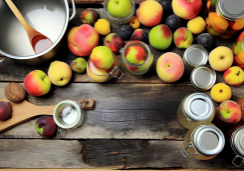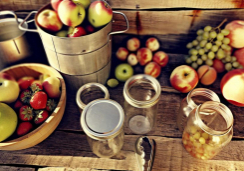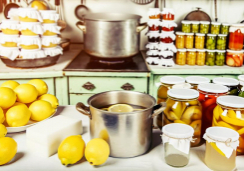Unlocking Crisp Perfection: Top Veggie Stir-Fry Secrets
As you stand in your kitchen, wok at the ready, you can't help but feel like an artist, poised to create a masterpiece not unlike Van Gogh with his palette of vibrant colors.
Yet, your canvas is the sizzling surface before you, and your paints, the array of fresh vegetables waiting to be transformed.
You understand that the secret to unlocking crisp perfection in a veggie stir-fry lies not just in the ingredients you choose, but in the techniques you apply.
From the essential equipment that empowers you to achieve that sought-after sear, to the precise cuts that optimize cooking times and textures, there's a myriad of subtle nuances to master.
As you embark on this culinary journey, you'll discover how to balance flavors and textures, ensuring that each bite is as harmonious as it is healthy.
But even as you learn the foundational steps, remember that the pinnacle of stir-fry artistry is not just about following rules—it's about knowing when to break them.
Stay tuned, and you'll uncover the stir-fry finishing techniques that elevate a simple dish into a symphony of taste and texture, leaving your guests wondering about the secrets behind your kitchen's curtain.
Essential Stir-Fry Equipment
Equipping your kitchen with the right tools, like a well-seasoned carbon steel wok and a rounded spatula, transforms stir-frying into an effortless culinary art. The wok, your canvas, conducts high heat swiftly, ensuring your veggies dance rather than wilt. A carbon steel wok not only fortifies with age but also boasts a high smoking point, vital for that searing heat which locks in flavors.
If you're pairing your wok with an electric or induction stove, opt for a flat-bottomed wok to guarantee even cooking. As you pivot your stir-fry ingredients with a rounded spatula, the wok's sloping sides allow for a swift toss, mimicking the actions of a seasoned cookbook author. This motion keeps your veggies lively and coated in the sizzling embrace of hot oil.
Mastering Vegetable Prep
Having equipped your kitchen with the right tools, let's focus on the art of vegetable preparation, ensuring your stir-fry ingredients are primed for the wok's fiery dance.
As you heat your wok to a high temperature, ready to unleash the power of quick cooking, turn your attention to the vegetables. It's crucial to cut all your veggies into bite-sized pieces, not just for ease of eating but to guarantee each morsel cooks evenly, retaining that sought-after crunchy texture.
Start by tackling vegetables like carrots, which demand a bit more time in the wok's embrace. These are your foundation, the hardy elements that add harder-to-achieve crunch. Add these to the wok first, giving them a head start before their softer companions join the mix.
Speaking of softer vegetables, they're the delicate notes in your stir-fry symphony, added later to avoid overcooking into a mushy afterthought.
Achieving High-Heat Cooking
To unlock the full potential of your stir-fry, start by preheating your wok until it's searing hot, ready to sizzle the moment your veggies hit the surface. This isn't just about wok cooking; it's about summoning the 'breath of a wok'—that elusive, smoky essence that elevates your vegetable stir-fry from mundane to magical.
Aim for high-heat cooking, which ensures your medley of greens and colors cooks quickly, retaining their snap and nutrients. You're not just cooking; you're orchestrating a rapid-fire culinary ballet where timing is everything. Choose oils wisely; a high smoke point is key. Peanut, canola, or soybean oil can withstand the heat without burning, while a drizzle of sesame oil adds a nutty finish.
Add a small amount of oil to coat the wok's surface. Heat it until it shimmers like a mirage, then introduce your vegetables in quick succession. A splash of soy sauce can add depth, but let the heat work its magic first. Caramelization will soon dance across your ingredients, teasing out flavors you didn't know your veggies possessed. High-heat wok cooking doesn't just cook food—it transforms it.
Balancing Flavors and Textures
Mastering the art of stir-fry requires an intuitive sense of balance, deftly blending sweet, sour, salty, spicy, and bitter flavors, while thoughtfully juxtaposing textures for a truly satisfying culinary experience. When you wield your wok, consider the symphony of tastes and the dance of textures that transform ordinary ingredients into extraordinary meals.
To captivate your taste buds, include:
- Sweet and sour: Employ rice vinegar to add a tart kick, harmonizing with sweet elements like bell peppers or a dash of sugar.
- Crunchy delights: Introduce sugar snap peas or Baby Corn, which not only contribute a satisfying crunch but also a subtle sweetness that elevates the dish.
- Savory depth: Swirl in oyster sauce for that rich, umami flavor that pairs impeccably with fresh herbs and tender snow peas.
Stir-Fry Finishing Techniques
As you near the crescendo of your veggie stir-fry, the final flourish lies in the artful application of your chosen sauce, ensuring each ingredient sings with flavor. It's time to transform those leftover vegetables into a symphony of taste.
Small pieces of protein, perhaps marinating meat or even char siu, if you fancy, have mingled with the greens in the sizzling dance of olive oil. Now, as you've been stirring the ingredients continuously, it's crucial to lavish them with a generous sauce.
If your heart leans towards the exotic, you might opt for a Thai basil-infused concoction, drizzling it over the hot pan's contents. The sauce's role is paramount, especially when you've doubled it to cling to every morsel, perfect for drenching rice or noodles that await their savory companion.
Keep in mind, this quick and easy process demands your undivided attention; the sauce should simmer just long enough to adhere to the veggies and protein, but short enough to preserve their crispness. Once you've adjusted the flavors to your taste, set aside your creation.
The result is a stir-fry that's not only personalized to your palate but also creatively seasoned to perfection.
Frequently Asked Questions
What Is the Secret to a Successful Stir Fry?
To nail stir-fry, you'll need high heat, proper cutting, and dry vegetables. Choose your oil wisely, master stirring technique, build an aromatic base, control the heat, add ingredients in order, and explore marination magic.
What Is the Secret Ingredient in Stir Fry?
The secret ingredient in your stir-fry is a combo of umami boosters, aromatic additions, and a precise balance of sauces. You'll nail flavor by choosing the right oil and mastering heat control.
How Do You Keep Vegetables Crisp in a Stir Fry?
To keep veggies crisp in a stir-fry, use high heat and a quick toss with minimal oil. Pre-cut for uniformity, dry them well, and avoid overcrowding. Use proper utensils and consider an ice bath.
What Are the Secrets to Perfect Stir-Frying According to a Chinese Restaurant Chef?
For perfect stir-frying, you'll want to crank up the heat, choose your wok wisely, and select oils with high smoke points. Prep thoroughly, master cutting techniques, cook in batches, and stir constantly.
Conclusion
Now you're equipped with stir-fry mastery—from wielding the right tools to perfecting vegetable prep, high-heat antics, and flavor balancing. Your stir-fries will sing with crispness and harmony.
Remember, it's the final touches that count: a splash of sauce, a sprinkle of herbs. So go ahead, dazzle your senses and plate up that vibrant, crunchy medley.
Each bite reflects your culinary finesse—your kitchen, your rules. Unlock that crisp perfection, one stir-fry at a time.










